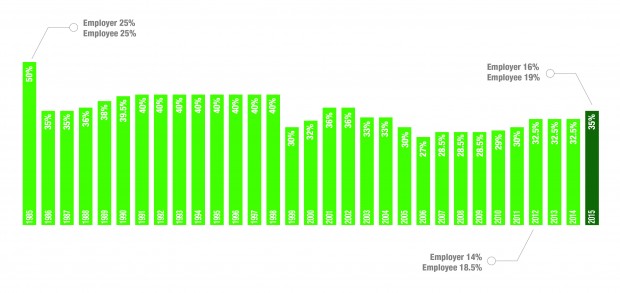Every year, the Singapore Budget prepared by Ministry of Finance is of a great concern to Singaporeans as it directly and indirectly impacts our livelihood for the rest of the year. Deputy Prime Minister (DPM) Tharman Shanmugaratnam Budget 2014 statement delivered on 21 February 2014 aroused quite a bit of excitement. He shared that Budget 2014 will focus on nurturing quality growth and building a fair and equitable society. Quality growth will be based on innovation and deeper capabilities to sustain rising incomes for Singaporeans and avoid indefinite expansion of the foreign workforce. Social safety nets will be strengthened and inequalities will be reduced while at the same time keeping quality healthcare affordable to all. Overall, the new budget looks nice and rosy but the devil is in the details. Let’s break it down and understand what it really meant for our local workforce as a whole.
Increase in CPF Contribution
Just weeks ahead of the Budget statement, the National Trades Union Congress (NTUC) called for an inclusive review of the Central Provident Fund (CPF) contribution rates for workers of all ages. They hope to see enhancement in the employer contribution to the Medisave accounts of workers in all age groups, in view of rising health-care costs and medical insurance premiums as well as higher CPF contribution by employers for older Singaporeans.
In case you have forgotten, a decision was made to reduce the total CPF contribution rates for elderly workers between age 50 up to 55 during 2005 and 2006 to help make it easier for our elderly workers to get a job. The employment rates of these elderly workers in this age group were significantly lower than those of the younger ones and seniority-based wages discouraged employers from hiring them.
But times have changed, employers have since moved towards a performance-based wage system, we have a re-employment legislation in place and employers who hire workers aged above 50 also receive the Special Employment Credit from the Government. We have also witnessed the resident employment rate of our older workers rose by about 10 percentage points over the last decade.
Thankfully, the call for an increase in employer’s CPF contribution got answered in Budget 2014. Central Provident Fund (CPF) Medisave employer contribution rate was raised by 1 percentage point for all workers from January 2015. CPF contribution rates for workers aged 50 to 55 was raised by 1.5 percentage points were 1 percentage point comes from the employer and 0.5 percentage points from the employee. Employer contribution rate for those aged 55 to 65 will also increase by 0.5 percentage points.
With Singaporeans getting married and starting families later, the increase in Medisave contribution will come in handy for their ageing parents and provide for an additional shelter during rainy days. In view of longer life expectancies, older workers will also enjoy more savings for their retirement and be more independent with taking care of their medical fees.
Top Up Of Lifelong Learning Endowment Fund
NTUC’s Labour MP, Patrick Tay has long been advocating for Professionals, Managers and Executives (PMEs) to go for second skilling. It basically means developing an additional skill that in time can double up as a source of income to cope with unforeseen circumstances such as retrenchment and unemployment. I am personally a strong supporter of this initiative.
It is encouraging to see that more funds will be pumped in to help support the upgrading of skills of workers through the Lifelong Learning Endowment Fund. The Lifelong Learning Endowment Fund will be increased by S$500 million, bringing the fund size to S$4.6 billion.
PMEs need to grab this opportunity to upgrade and enhance their personal competitiveness for job security and at the same time kickstart their second skilling initiative.
Productivity & Innovation Credit
Increased productivity is essential for wage growth. Companies need to be more productive, by creating goods and services at a cheaper cost, better quality and at a faster rate. The idea is to raise profits or cut non-labour costs so the company has a higher profit margin and becomes more competitive than its competitors.
Althoughleadsmajority of business owners and senior management openly embrace innovation, many shun taking action to change their existing workflow, adopt the use of new technology and choose to live by the rules of ‘If it ain’t broke, don’t fix it’. Problems are solved “as-they-come-along” using reactive changes in a piecemeal manner. The result is that these types of companies don’t have the long-term competitiveness and find it difficult to raise wages when they’re just trying to survive the fires of today.
The labour movement has long been calling for productivity improvements for sustainable wage growth. Funding and know-how were provided to support companies which are brave enough to think and act out of the box. It is heartening to see that the latest budget is pro-active with supporting companies to accelerate the adoption of ICT to increase productivity.
Investing in better technology allow workers to do their job easier, smarter, safer. Coupled with effective training, they will go a long way with providing the sustained productivity growth for higher wages.
Time For Action
The actual implementation of these new initiatives on enhancing productivity and welfare for workers may be a challenge but it is definitely a move in the right direction. Hong Kong with its close resemblance to Singapore economy offered an interesting case study on the effectiveness of minimal wage. A minimum wage that is not supported by productivity growth only lead to higher inflation and hardship of low wage workers. Minimum wage despite its attractive short term promises is definitely not the way to go for Singapore.
The stage is now set for a better workers’ welfare, continuous learning and higher productivity. Are you ready to ride the wave of change?








